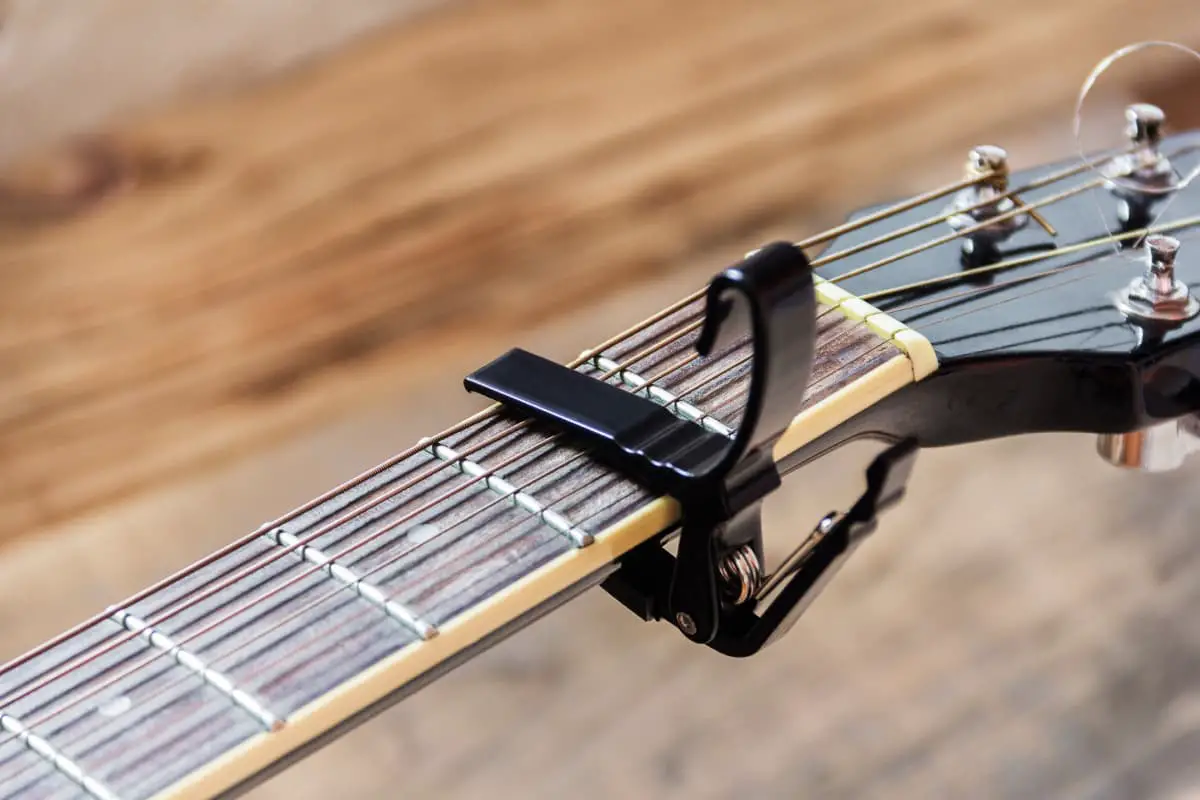There are many topics guitar players debate about when discussing the best way to perform with their instrument. Every musician has their own preferences for playing, and what suits one person’s tastes may not be beneficial for another. One of those talked-about topics is whether or not using a capo makes it easier or more challenging to play.
Using a guitar capo can assist in changing keys, making barre chords, and writing music. A guitar capo will not help when you are trying to create quality vibrato sounds, play solos, get the correct string tension, or have precise control over your instrument.
This article will cover eight reasons why using a capo while playing your guitar can be beneficial, and eight reasons why trying to work around one might be more of a hassle than a help. Keep reading this article if you need help deciding whether using a guitar capo is the best choice for you.
👇😀👇NOTE👇😀👇
If you want to find out what my recommended guitar gear is, then here is what I recommend on Amazon:
- Fender Cutaway Acoustic-Electric Guitar Bundle (MY FAVORITE GUITAR)
- Snark SN-8 Super Tight All Instrument Tuner (Easiest Tuner I’ve Used😏)
- 6 String Acoustic Guitar Capo (Best CAPO for quick changes)
- Dunlop Max Grip 1.0mm Nylon Picks (Thick Guitar Pick So You Don’t Lose Grip!)
- Universal Guitar Stand (Cheap & Minimalist Guitar Stand I Recommend)
- Levy’s 2″ Wide Quick Adjust Guitar Strap (Best Guitar Strap For Any Level)
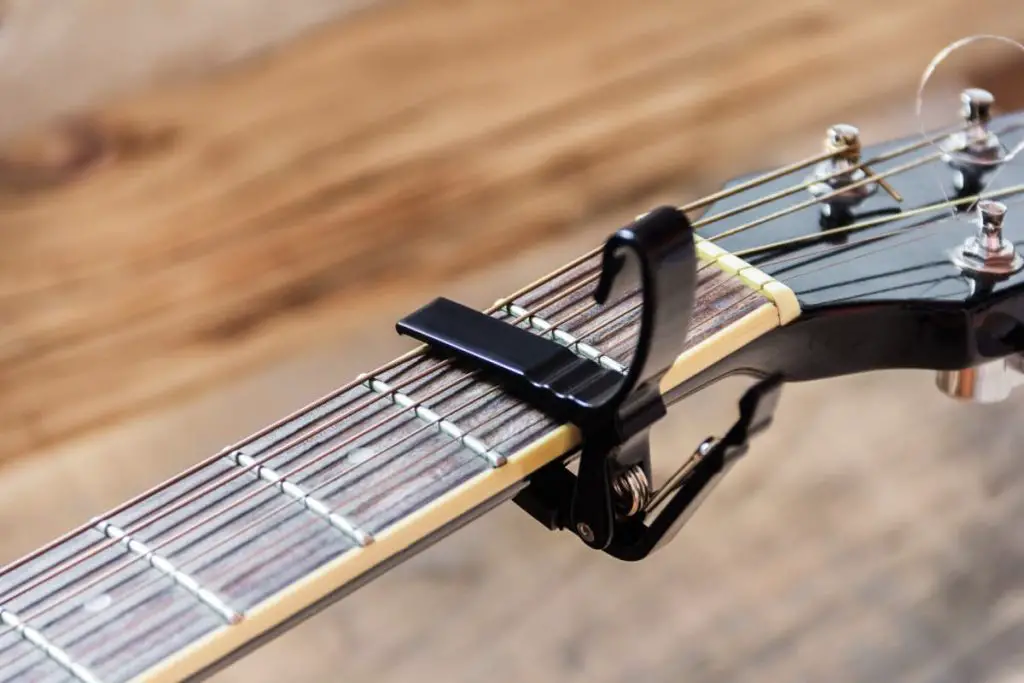
The Pros of Using a Guitar Capo
Although some more experienced musicians may stick up their noses at the idea of using a guitar capo, there are actually quite a few benefits to having one around while playing your instrument.
Guitar Capos Change the Key Easily
One of the most common reasons you see guitarists play with a capo is that it helps make it easier to play in a broader range of keys. When you place a capo on your guitar, it automatically changes the key you are playing in. It shortens the strings shortens, thus changing their pitch.
Using a capo to change the key of a song is extremely helpful for singers who like a particular tune but may not have the proper vocal range to sing it well. By shifting the capo once or twice, a song that was once too high or low can now sit perfectly in a singer’s range.
Capos also allow you to experiment with new sounds when you place them on different sections of the neck of the guitar. You can play around with songs in entirely different keys just to get a feel for what they would sound like in a higher or lower range.
And I’m not even mentioning the fact that many songs are meant to be played with a capo. It’s definitely a tool you want to have at hand if you want to be able to play any song you hear.
Guitar Capos Limit the Chord Shapes You Have To Learn
Playing any chord on the guitar requires learning a new hand shape. Getting the hang of all of these chord shapes can be tricky and time-consuming for beginners, particularly after they have mastered the easier ones.
Putting a capo on your guitar can make the process of learning the different positioning for each new note a little less troublesome.
If you can master the most commonly-used hand shapes, you just have to add a capo to any spot on the neck to change the key you are playing in. Then, using those same hand motions, you will be able to play new chords depending on the placement of the capo.
Guitar Capos Change the Sound of the Guitar
The most significant difference that a guitar capo makes in the sound coming from the instrument is how bright the chords sound the further you go down the frets.
Because the capo is clamping down the strings, there is going to be more tension in them the closer you get to the bottom of the neck. This tension will create a lighter, more twangy noise, and the chords will not sound so deep as you move down the frets.
The added brightness will allow you to expand the sounds your guitar can make, and you will be able to do more with fewer changes to how your hands are positioned on the guitar.
Guitar Capos Lower the Action of the Strings
With a guitar capo clamped onto your instrument, the strings will adjust to sitting closer to the frets. When this happens, it means that the action of the strings has been lowered.
Having the action of the strings taken care of by the capo is a great asset, particularly to beginners who are just learning how to play barre chords. The capo holding down the strings allows you to change chords more quickly, making it easier to play a wider variety of combinations.
Having a lower string action also makes it less tiring to play faster because you don’t have to press down all of the strings consistently. You will also be able to play for longer since your hands will not be as tired from the constant pressing.
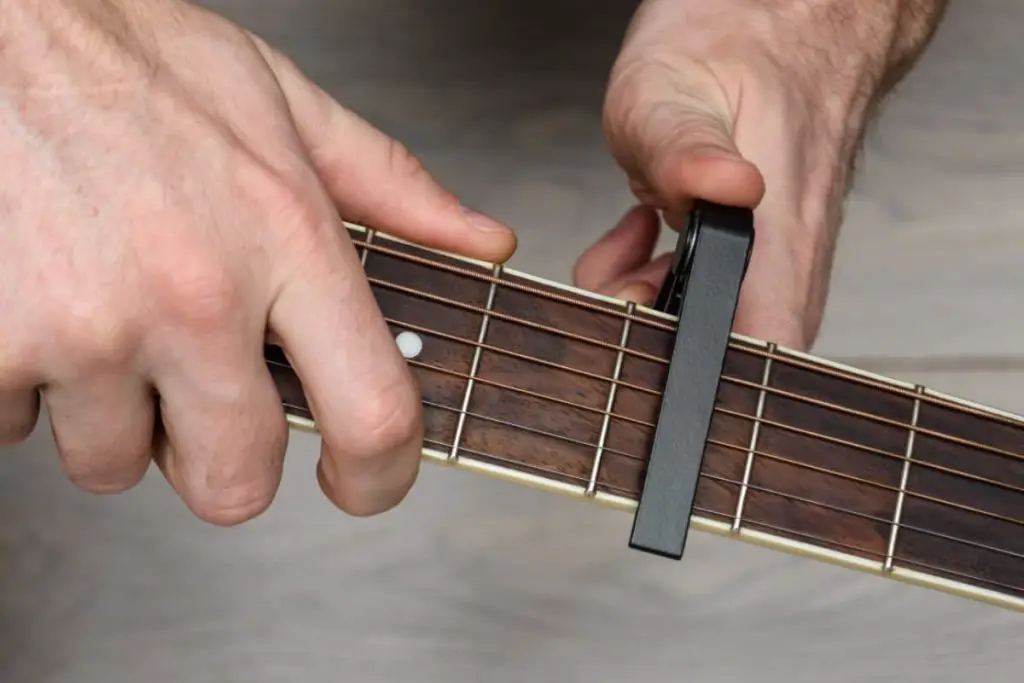
Guitar Capos Make Playing Barre Chords Easier
A massive benefit of using a capo when playing guitar is that the device will barre the entire fret off, making playing barre chords much more manageable.
To play a barre chord, you have to exert a lot of force with your fingers—especially if you’re a beginner. Constantly holding down the strings will likely be uncomfortable and difficult if you are not an experienced guitar player.
With a capo, the strings are already pressed down into place, so you don’t have to worry about whether you’re using enough strength. You can just concentrate on improving your form.
Guitar Capos Provide Opportunities for Experimenting
Another positive aspect of using a capo on your guitar is that it gives you more flexibility for learning new material.
If you know a few of the most common basic chord shapes, you may already be able to play several different songs. Adding a capo into the mix will expand your library of tunes even more by changing the key in which you are playing.
Let’s say you know four beginner notes and their hand shapes. If you move the capo farther up or down the neck of the guitar, you will automatically be playing in a new key. Those same four hand shapes will produce different chords depending on where the capo is placed. The adjusted location will allow you to play an entirely new collection of songs!
Guitar Capos Help With Songwriting and Composition
If you like writing your own songs on the guitar, using a capo can immensely assist with your composition process.
Maybe you’ve come up with a chord progression you like, but you find that it’s a bit too high or too low for you to sing. You can manually transpose the song to a different key, but when you’re composing, you probably just want to get to experimenting and trying stuff as quickly as possible. Using a capo makes this process much faster.
In addition to providing you with the ability to play multiple chords in multiple keys, the capo will also change the sound the guitar produces depending on where it’s placed on the frets. Moving the capo around to different spots on the instrument will give you endless possibilities for creating music.
There are a few tricks you can try, like choosing one of your favorite songs to play and moving the capo one or two frets over. Even doing just this will make the tune sound different from the original. After moving the capo, try changing strum patterns to make it sound even more unique.
You can also take one of the chord progressions you like best and play it with the capo in new positions. By moving it around just slightly, your guitar will produce a wide variety of sounds, and you can use the ones you like best to help you make your own music!
Guitar Capos Give Your Hands a Break
Perhaps the most straightforward but most helpful part of playing your guitar with a capo is that it gives your hands a rest.
Sore, callused fingers are an issue for any guitar player, particularly those new to the instrument (more info here on guitar calluses). The hand that’s holding down the strings to create the chords can become exhausted and uncomfortable, especially if you are playing a fast song.
Attaching a capo to your guitar does a lot of the work for that hand. It holds down the strings for you when barre chords start to become challenging to play, giving your fingers a much-needed break.
The Cons of Using a Guitar Capo
Some musicians consider the capo an unnecessary clutch—and it’s true that you don’t really need a capo. However, it makes more sense to see it simply as a tool. Sure, if you rely exclusively on the capo to play barre chords, you’ll be in trouble later. However, when you use the capo with a purpose, it becomes a wonderful tool.
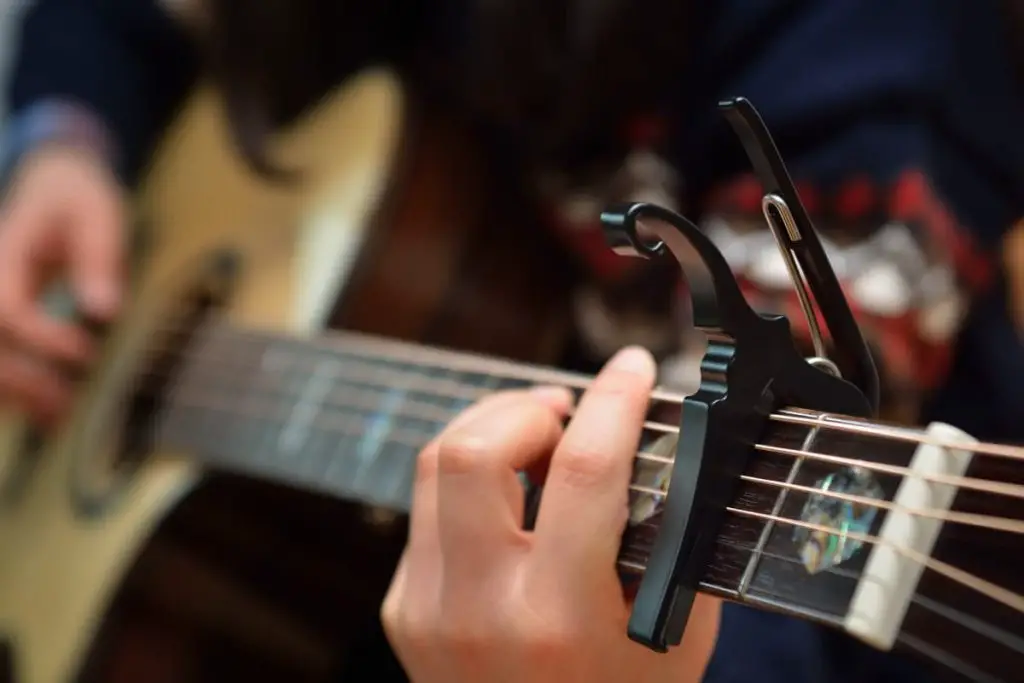
However, setting that aside, there are several legitimate cons to using a capo. Let’s take a look at them.
Guitar Capos Cause You To Lose Range
In general, the purpose of a capo is to hold down the strings in a certain fret of your guitar. While this purpose can certainly have some positive effects, it also means that you will not be able to play every note on your guitar.
With the capo clamped down on the neck, you will inevitably be restricted from playing the full range of notes of a guitar. It will likely prevent you from playing the highest and lowest chords.
Guitar Capos Do Not Allow Vibrato To Happen
The nature of what the capo does means that making the strings of your guitar vibrate is going to be a bit more challenging.
When you want to play vibrato on your guitar, you move your fingers quickly so the strings rock back and forth, creating that iconic quivering sound. If you have a capo clamping down over the strings, the tension is going to be shortened, and you will not be able to make that same shaking sound.
A capo can also cause trouble when you are trying to perform guitar harmonics. The tightness of the strings will not permit you to move them in the way needed to get the proper overtones.
Guitar Capos Do Not Let the Strings Bend
Just like with vibrato and harmonics, using a capo makes playing bends a bit more complicated because of the amount of tension sitting on the strings.
When the strings are only being held in place by the nuts at the top of the neck, they have much more flexibility and can bend up and down quite a bit. Putting a capo over the strings will restrict their ability to bend considerably.
If you are limited on how much you can bend the strings, you won’t be able to get very creative while you are playing. The capo will only allow you to play basic chord shapes.
Guitar Capos Make Soloing Difficult
As mentioned previously, a capo will not let you bend the strings of your guitar easily. One of those times that you would want to be able to bend the strings is while playing a solo.
When you solo on your instrument, you are required to hit the right notes in a rapid motion, and a lot of the time, that involves bending the strings. If you do not have that fluidity available to you, your ability to solo will be significantly restricted.
Capos also prevent you from reaching lower notes on your guitar since they automatically move up the key you are playing in. Again, this will make performing an excellent solo tough because you will not have as much room to freestyle.
Besides, when you’re playing a solo, you’ll want to be as expressive as possible. A capo removes some of your tools for creating expressive sounds, such as vibrato and bends.

Guitar Capos Take Away Richness Form the Sound
Another reason you may decide not to use a capo is that it prevents your guitar from making an open, full sound. When you are playing your instrument with nothing holding the strings back except your fingertips, it will create a rich musicality that just cannot be reproduced with a capo attached.
There are also some sounds that are not easy to recreate with a capo on your guitar. For example, it is tough to imitate low bass notes with a capo clamping down the strings.
Depending on where the capo is placed, it will inevitably move up the key and won’t leave enough room for the guitar to play lower notes.
Guitar Capos Can Create Tuning Problems
There are several different types of capos available to purchase, and each of them comes with its own potential downsides. If the capo you are using does not have an adjustable spring, the lack of flexibility could cause trouble on either side.
If the capo’s tension is too weak, it will not hold the strings down correctly, and you will not get the sound you are looking for. This is when tuning issues could occur. If the capo is not clamped hard enough over the fret, there will be too much room for the strings to vibrate, which could create a buzzing sound.
On the other hand, if the tension of the capo is too tight on the guitar, you will not get a high-quality sound either. The strings will not have room to move the way they need to, and the sound will be stunted.
Guitar Capos Do Not Always Fit Properly
A guitar capo not fitting correctly on the instrument’s neck will often happen when you’re using a cheap device, like a strap or a low-quality metal capo. While purchasing an affordable version of a product is not always a bad decision, in this case, it has the potential to turn out poorly.
If the capo does not fit correctly, you likely won’t have precise control over where it sits on the neck of the guitar. In this scenario, as in the one mentioned previously, the strings will likely either have too much or not enough tension, and your music will not come out sounding how you would like it to.
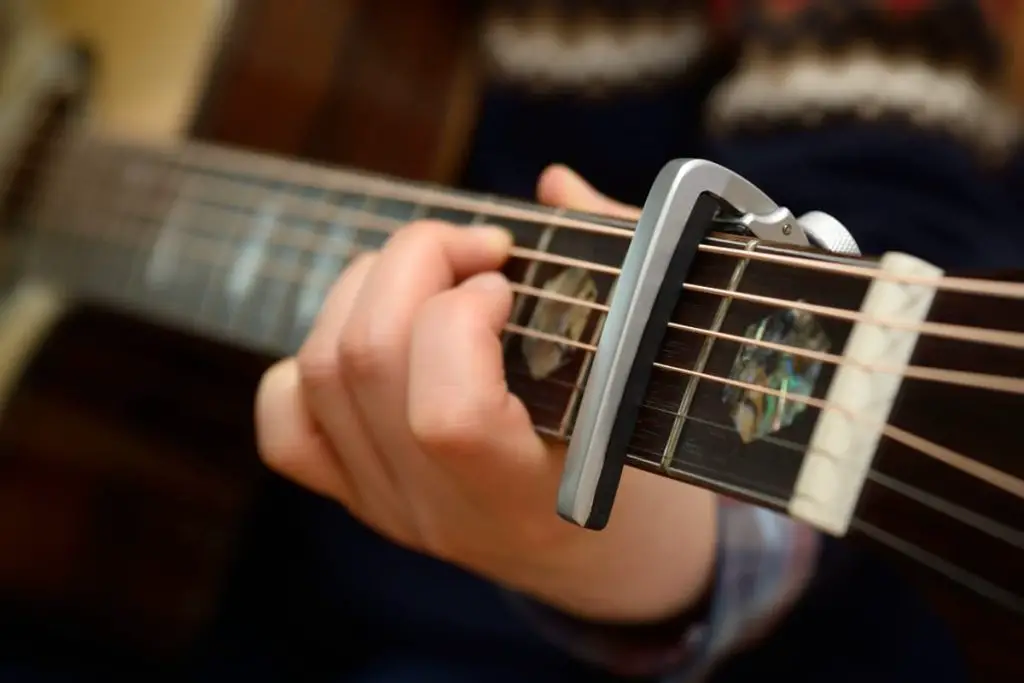
Guitar Capos Can Add Weight to Your Instrument
A more expensive capo will definitely do a much better job of keeping the strings in place and giving you a nicer sound. The only problem you may find with a higher-quality capo is that it’s too bulky.
Fancier capos often come with extra parts that, while beneficial to your music-playing process, can be heavier than your average capo. A device like this has the potential to add weight to the neck of your guitar, which can provide some discomfort while you’re playing.
Final Thoughts
Guitar capos are ingenious little devices that can make a massive difference in your playing abilities, both for better and for worse.
As with any other musical product, there are going to be positive and negative attributes that come with performing using a capo. It may suit some people’s needs more often than it does others.
Depending on what you need to use a guitar capo for, it has the potential to be a really helpful tool for your music-making.
👇😀👇NOTE👇😀👇
If you want to find out what my recommended guitar gear is, then here is what I recommend on Amazon:
- Fender Cutaway Acoustic-Electric Guitar Bundle (MY FAVORITE GUITAR)
- Snark SN-8 Super Tight All Instrument Tuner (Easiest Tuner I’ve Used😏)
- 6 String Acoustic Guitar Capo (Best CAPO for quick changes)
- Dunlop Max Grip 1.0mm Nylon Picks (Thick Guitar Pick So You Don’t Lose Grip!)
- Universal Guitar Stand (Cheap & Minimalist Guitar Stand I Recommend)
- Levy’s 2″ Wide Quick Adjust Guitar Strap (Best Guitar Strap For Any Level)
Related Posts:
- How Do Chords Change With a Capo? How To Use A Capo
- Can You Use A Capo On An Electric Guitar?
- What Key Is A Guitar In Without A Capo?
- Can You Tune A Guitar With A Capo On? Here’s The Answer
- Why Do Guitarists Use Capos? (And Why You Should Too)
- How To Play Capo Songs Without A Capo: DIY Methods
- Can A Capo Damage Your Guitar Or Strings?
- Guitar Capo (Guitar Chords Capo Calculator): The Best Guitar Capos

